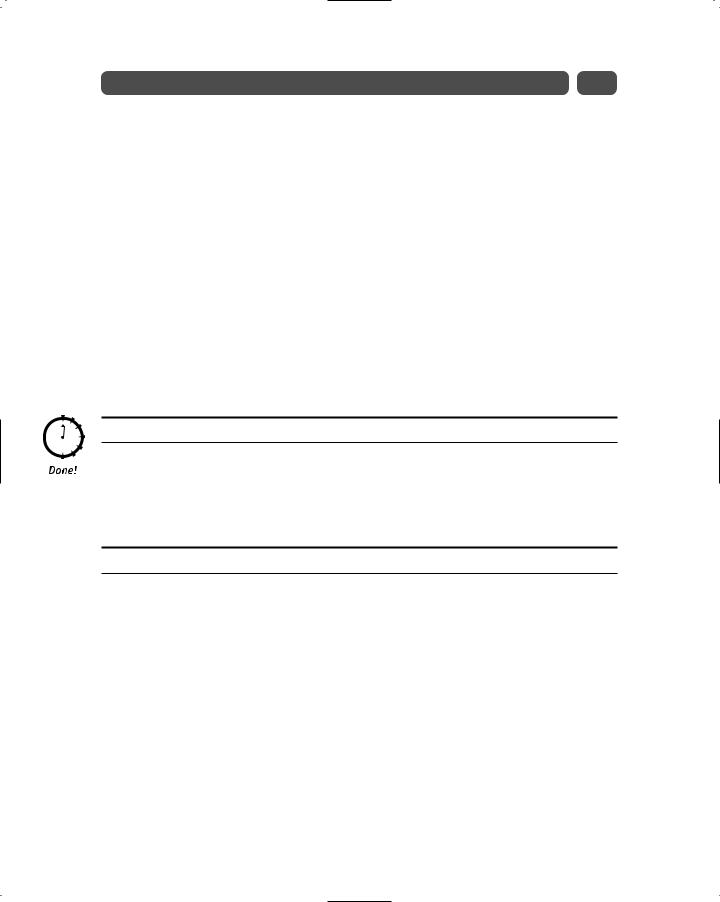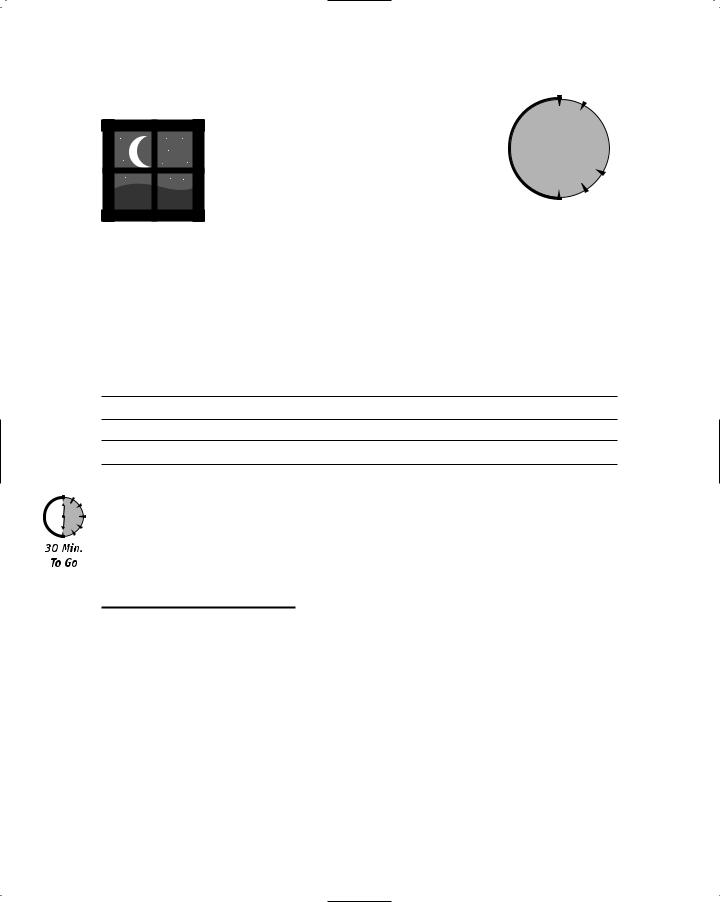
- •Preface
- •Who Should Read This Book
- •Organization and Presentation
- •Contacting the Authors
- •Acknowledgments
- •Contents
- •Introduction
- •Why Microsoft .NET?
- •The Microsoft .NET Architecture
- •Internet Standards
- •The Evolution of ASP
- •The Benefits of ASP.NET
- •What Is .NET?
- •.NET Experiences
- •.NET Clients
- •.NET Services
- •.NET Servers
- •Review
- •Quiz Yourself
- •Installation Requirements
- •Installing ASP.NET and ADO.NET
- •Installing the .NET Framework SDK
- •Testing Your Installation
- •Support for .NET
- •Review
- •Quiz Yourself
- •Designing a Database
- •Normalization of Data
- •Security Considerations
- •Review
- •Quiz Yourself
- •Creating a Database
- •Creating SQL Server Tables
- •Creating a View
- •Creating a Stored Procedure
- •Creating a Trigger
- •Review
- •Quiz Yourself
- •INSERT Statements
- •DELETE Statements
- •UPDATE Statements
- •SELECT Statements
- •Review
- •Quiz Yourself
- •The XML Design Specs
- •The Structure of XML Documents
- •XML Syntax
- •XML and the .NET Framework
- •Review
- •Quiz Yourself
- •ASP.NET Events
- •Page Directives
- •Namespaces
- •Choosing a Language
- •Review
- •Quiz Yourself
- •Introducing HTML Controls
- •Using HTML controls
- •How HTML controls work
- •Intrinsic HTML controls
- •HTML Control Events
- •The Page_OnLoad event
- •Custom event handlers
- •Review
- •Quiz Yourself
- •Intrinsic Controls
- •Using intrinsic controls
- •Handling intrinsic Web control events
- •List Controls
- •Rich Controls
- •Review
- •Quiz Yourself
- •Creating a User Control
- •Adding User Control Properties
- •Writing Custom Control Methods
- •Implementing User Control Events
- •Review
- •Quiz Yourself
- •Common Aspects of Validation Controls
- •Display property
- •Type Property
- •Operator Property
- •Using Validation Controls
- •RequiredFieldValidator
- •RegularExpressionValidator
- •CompareValidator
- •RangeValidator
- •CustomValidator
- •ValidationSummaryx
- •Review
- •Quiz Yourself
- •Maintaining State Out of Process for Scalability
- •No More Cookies but Plenty of Milk!
- •Out of Process State Management
- •Review
- •Quiz Yourself
- •Introducing the Key Security Mechanisms
- •Web.config and Security
- •Special identities
- •Using request types to limit access
- •New Tricks for Forms-based Authentication
- •Using the Passport Authentication Provider
- •Review
- •Quiz Yourself
- •ASP.NET Updates to the ASP Response Model
- •Caching with ASP.NET
- •Page Output Caching
- •Absolute cache expiration
- •Sliding cache expiration
- •Fragment Caching
- •Page Data Caching
- •Expiration
- •File and Key Dependency and Scavenging
- •Review
- •Quiz Yourself
- •A Brief History of Microsoft Data Access
- •Differences between ADO and ADO.NET
- •Transmission formats
- •Connected versus disconnected datasets
- •COM marshaling versus text-based data transmission
- •Variant versus strongly typed data
- •Data schema
- •ADO.NET Managed Provider Versus SQL Managed Provider
- •Review
- •Quiz Yourself
- •Review
- •Quiz Yourself
- •Creating a Connection
- •Opening a Connection
- •Using Transactions
- •Review
- •Quiz Yourself
- •Building a Command
- •Connection property
- •CommandText property
- •CommandType property
- •CommandTimeout property
- •Appending parameters
- •Executing a Command
- •ExecuteNonQuery method
- •Prepare method
- •ExecuteReader method
- •Review
- •Quiz Yourself
- •Introducing DataReaders
- •Using DataReader Properties
- •Item property
- •FieldCount property
- •IsClosed property
- •RecordsAffected property
- •Using DataReader Methods
- •Read method
- •GetValue method
- •Get[Data Type] methods
- •GetOrdinal method
- •GetName method
- •Close method
- •Review
- •Quiz Yourself
- •Constructing a DataAdapter Object
- •SelectCommand property
- •UpdateCommand, DeleteCommand, and InsertCommand properties
- •Fill method
- •Update method
- •Dispose method
- •Using DataSet Objects
- •DataSetName property
- •CaseSensitive property
- •Review
- •Quiz Yourself
- •Constructing a DataSet
- •Tables property
- •TablesCollection Object
- •Count property
- •Item property
- •Contains method
- •CanRemove method
- •Remove method
- •Add method
- •DataTable Objects
- •CaseSensitive property
- •ChildRelations property
- •Columns property
- •Constraints property
- •DataSet property
- •DefaultView property
- •ParentRelations property
- •PrimaryKey property
- •Rows property
- •Dispose method
- •NewRow method
- •Review
- •Quiz Yourself
- •What Is Data Binding?
- •Binding to Arrays and Extended Object Types
- •Binding to Database Data
- •Binding to XML
- •TreeView Control
- •Implement the TreeView server control
- •Review
- •Quiz Yourself
- •DataGrid Control Basics
- •Binding a set of data to a DataGrid control
- •Formatting the output of a DataGrid control
- •Master/Detail Relationships with the DataGrid Control
- •Populating the Master control
- •Filtering the detail listing
- •Review
- •QUIZ YOURSELF
- •Updating Your Data
- •Handling the OnEditCommand Event
- •Handling the OnCancelCommand Event
- •Handling the OnUpdateCommand Event
- •Checking that the user input has been validated
- •Executing the update process
- •Deleting Data with the OnDeleteCommand Event
- •Sorting Columns with the DataGrid Control
- •Review
- •Quiz Yourself
- •What Is Data Shaping?
- •Why Shape Your Data?
- •DataSet Object
- •Shaping Data with the Relations Method
- •Review
- •Quiz Yourself
- •OLEDBError Object Description
- •OLEDBError Object Properties
- •OLEDBError Object Methods
- •OLEDBException Properties
- •Writing Errors to the Event Log
- •Review
- •Quiz Yourself
- •Introducing SOAP
- •Accessing Remote Data with SOAP
- •SOAP Discovery (DISCO)
- •Web Service Description Language (WSDL)
- •Using SOAP with ASP.NET
- •Review
- •Quiz Yourself
- •Developing a Web Service
- •Consuming a Web Service
- •Review
- •Quiz Yourself
- •ASP and ASP.NET Compatibility
- •Scripting language limitations
- •Rendering HTML page elements
- •Using script blocks
- •Syntax differences and language modifications
- •Running ASP Pages under Microsoft.NET
- •Using VB6 Components with ASP.NET
- •Review
- •Quiz Yourself
- •Preparing a Migration Path
- •ADO and ADO.NET Compatibility
- •Running ADO under ASP.NET
- •Early Binding ADO COM Objects in ASP.NET
- •Review
- •Quiz Yourself
- •Answers to Part Reviews
- •Friday Evening Review Answers
- •Saturday Morning Review Answers
- •Saturday Afternoon Review Answers
- •Saturday Evening Review Answers
- •Sunday Morning Review Answers
- •Sunday Afternoon Review Answers
- •What’s on the CD-ROM
- •System Requirements
- •Using the CD with Windows
- •What’s on the CD
- •The Software Directory
- •Troubleshooting
- •ADO.NET Class Descriptions
- •Coding Differences in ASP and ASP.NET
- •Retrieving a Table from a Database
- •Displaying a Table from a Database
- •Variable Declarations
- •Statements
- •Comments
- •Indexed Property Access
- •Using Arrays
- •Initializing Variables
- •If Statements
- •Case Statements
- •For Loops
- •While Loops
- •String Concatenation
- •Error Handling
- •Conversion of Variable Types
- •Index

Session 18—Executing Commands |
185 |
</SCRIPT>
<HTML>
<BODY>
<asp:ListBox ID=”lstBands” Size=”1” Runat=”server” /> </BODY>
</HTML>
In Listing 18-6, we use the following line of code to populate the DataReader object with the results of the query:
oDR = oCmd.ExecureReader()
Once the DataReader is populated, we iterate through the DataReader and add an Item to the ListBox server control, lstBands, for each record using the following statement:
lstBands.Items.Add(New ListItem(oDR.Item(“band_title”),oDR.Item(“band_id”)))
This method of populating controls with data is very fast, but not very flexible as the DataReader objects provide for forward-only navigation.
REVIEW
The ADO.NET Command objects, OleDbCommand and SqlCommand, are used to execute commands against a data source. With the Command objects you can execute SQL statements to insert, update, delete, or select data as well as create database objects such as stored procedures, tables, or triggers. Additionally, using the command object’s ExecuteReader() method, we can fill a DataReader object for forward-only navigation.
QUIZ YOURSELF
1.What is the main function of a Command object? (See session introduction.)
2.What Command property do you use to add parameters to a Command object? (See “Appending parameters.”)
3.What are the differences between the ExecuteReader () and ExecuteNonQuery () methods? (See “ExecuteNonQuery method.”)


S E S S I O N
19
Using DataReaders
Session Checklist
Understanding the function of the DataReader objects in ADO.NET
Filling a DataReader using the Command object’s Execute method
Moving through a DataReader
In the previous session, we introduced the ADO.NET Command objects. In this session, we build upon the previous discussion of Command objects and further discuss the ADO.NET DataReader objects. As usual, ADO.NET offers two flavors of DataReader objects:
OleDbDataReader and SqlDataReader. Just like the Connection and Command objects, you can use either to access a SQL Server database, but need to use the OleDbDataReader object to access any other data source.
Introducing DataReaders
So, what is a DataReader? A DataReader object is effectively a forward-only collection of records from your data source. The interesting thing about DataReaders is that they do not have a public constructor per se. The DataReader is created via a Command object’s ExecuteReader method. Another interesting thing to note about DataReader objects is that, unlike many other ADO.NET objects, they can’t be disconnected — that is, they always need an active connection. Thus, you can’t, for example, pass them between business objects. The purpose of the DataReader is to provide data for display, that’s it. The DataReader objects are lightweight and very fast so they are ideal for this purpose.
Looked at in terms of our telephone analogy, the DataReader is analogous to a recording you might get when say calling a restaurant and requesting directions. When you’re listening to the directions and feverishly trying to write everything down you might often miss something. The problem is, you can’t go back because the recording is forward-only. I guess you could call back! Same with a DataReader. It’s forward only!

188 |
Saturday Evening |
When creating a DataReader, start by declaring a variable as follows:
Dim oDR As OleDbDataReader
The next thing you need to do is construct your Connection and Command objects.
For more details on constructing Connection and Command objects, refer to Sessions 17 and 18.
 Cross-Ref
Cross-Ref
Next, initialize the DataReader object by calling the Command object’s ExecuteReader method as follows:
oDR = oCmd.Execute()
Now that is easy! Let’s bring it all together . . . The following example illustrates how to
(1) construct and open a Connection, (2) construct a Command, and (3) call the Command’s ExecuteReader method and pass the result to a DataReader, as shown in Listing 19-1.
Listing 19-1 Constructing a DataReader
<%@ Page Language=”VB” %>
<%@ Import Namespace=”System.Data” %>
<%@ Import Namespace=”System.Data.OleDb” %> <SCRIPT LANGUAGE=”VB” RUNAT=”server”>
Sub Page_Load(Sender As Object, E As EventArgs) Dim oConn As OleDbConnection
Dim oCmd As OleDbCommand
Dim oDR As OleDbDataReader
oConn = New OleDbConnection(“Provider=SQLOLEDB;Data
Source=(local);Initial Catalog=Music;User ID=music;Password=music”)
oConn.Open()
oCmd = New OleDbCommand() With oCmd
.Connection = oConn
.CommandType = CommandType.Text
.CommandText = “SELECT * FROM t_bands” oDR = .ExecuteReader()
End With End Sub </SCRIPT> <HTML> <BODY>
Creating a DataReader with ADO.NET </BODY>
</HTML>
